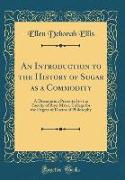- Start
- An Introduction to the History of Sugar as a Commodity
An Introduction to the History of Sugar as a Commodity
Angebote / Angebote:
Excerpt from An Introduction to the History of Sugar as a Commodity: A Dissertation Presented to the Faculty of Bryn Mawr, College for the Degree of Doctor of PhilosophyThe people of the Spanish Peninsula were at once the last to receive the cane at the hands of the Mohammedans, and the first to start it on its further migration across the Atlantic Ocean. In the early fifteenth century the islands nearer the Old World were planted with the sugar cane. From the Madeira and Canary Islands its culture spread southward to the islands about the equator - St. T homas and the rest. In the sixteenth century the first plantations were started in the New World, and the center moved from that time constantly toward the west. In the Spanish West Indies and in Mexico and Brazil on the mainland, promising harvests were reaped. This transplanting to the New World was the last great stage in the westward migration of the cane. Various political struggles were worked out in those early days in the tropical regions of America, as the European nations con tended for supremacy there, and the Spanish predominance in sugar culture was followed in turn by the English and the French.'About the PublisherForgotten Books publishes hundreds of thousands of rare and classic books. Find more at www.forgottenbooks.comThis book is a reproduction of an important historical work. Forgotten Books uses state-of-the-art technology to digitally reconstruct the work, preserving the original format whilst repairing imperfections present in the aged copy. In rare cases, an imperfection in the original, such as a blemish or missing page, may be replicated in our edition. We do, however, repair the vast majority of imperfections successfully, any imperfections that remain are intentionally left to preserve the state of such historical works.
Folgt in ca. 10 Arbeitstagen
